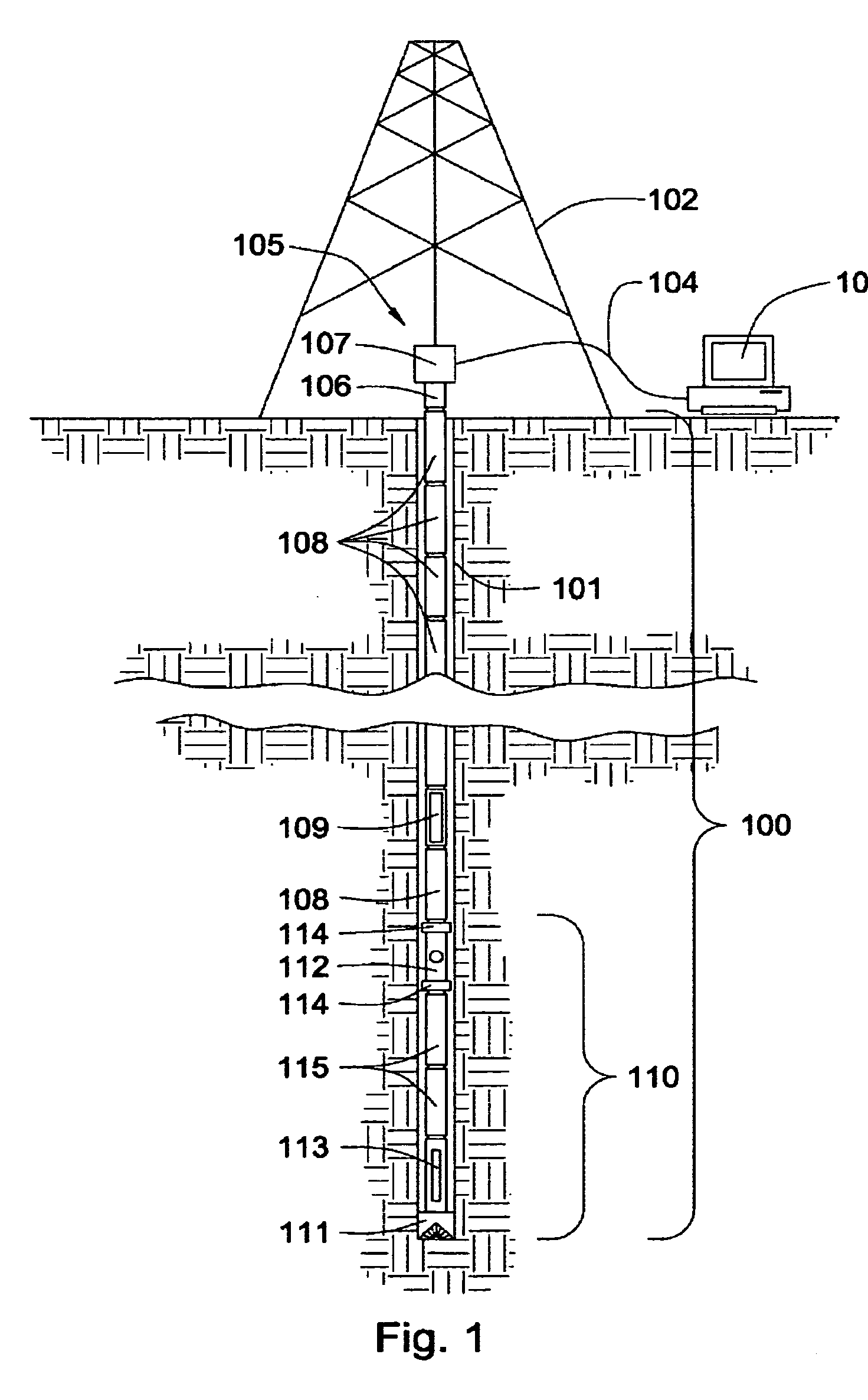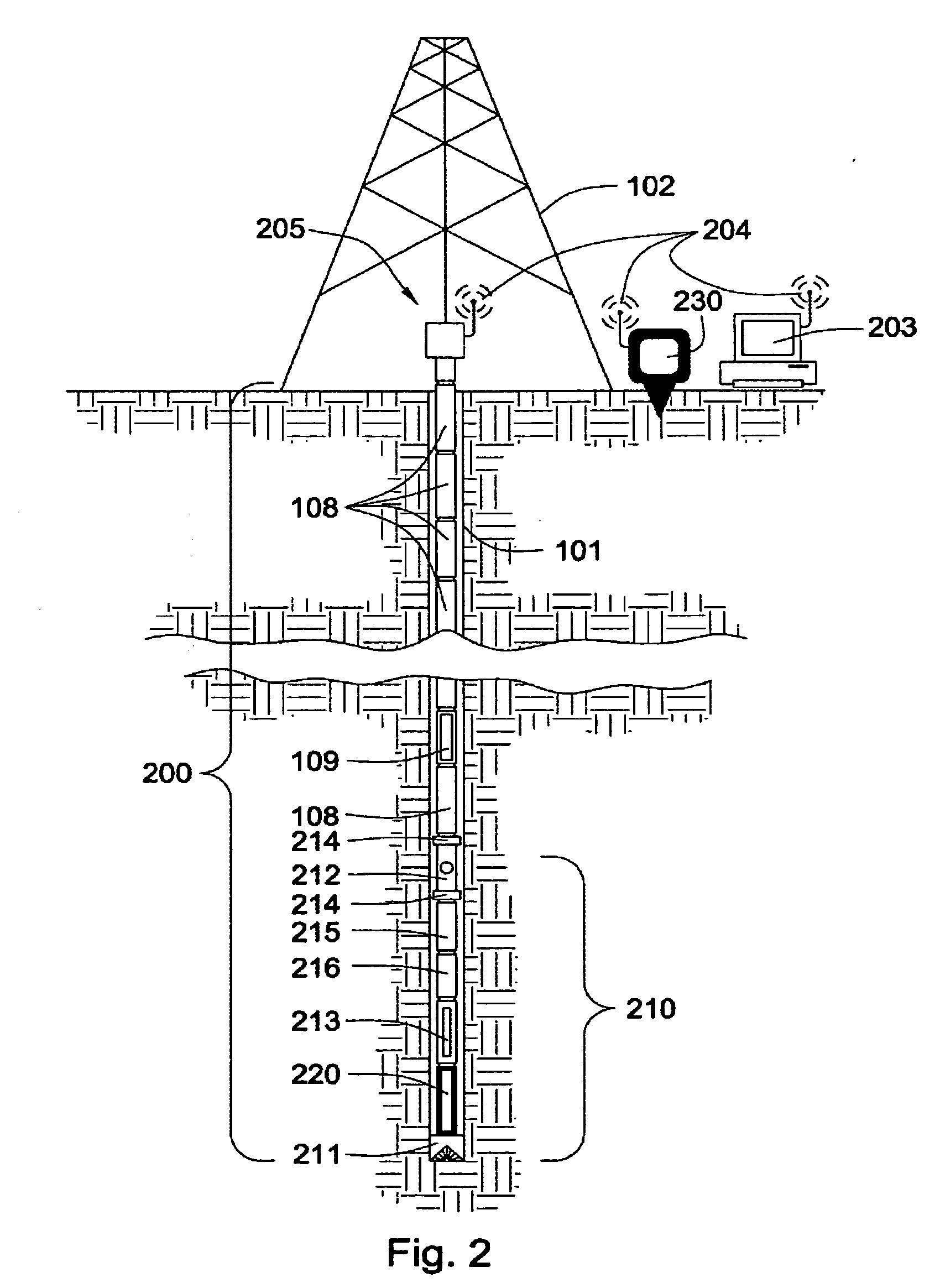Apparatus and method for seismic measurement-while-drilling
a technology of apparatus and method, applied in the field of apparatus and method for seismic measurementwhiledrilling, can solve the problems of noise, interference, attenuation, and surface seismic data cannot provide the velocity data that is required, and wireline seismic surveys typically require lengthy and expensive interruption of drilling process
- Summary
- Abstract
- Description
- Claims
- Application Information
AI Technical Summary
Benefits of technology
Problems solved by technology
Method used
Image
Examples
example 1
[0041]FIG. 1 shows a cross section of the preferred embodiment of the invention for RVSP MWD. A drill string 100, comprising an integrated data transmission network, is suspended in a well bore 101 from a derrick 102. Surface equipment 103, such as a computer, connects via a cable 104 to a data saver 105. The data saver is adapted to transmit data to and from the downhole portion of the integrated transmission network while the drill string is rotating and progressing forward into the earth. It may comprise an element 106 that rotates with the drill string and an element 107 that does not rotate and connects to the cable 104. The data saver may comprise means for transferring information through a rotating joint, such as a slip ring or an inductive coupler. To avoid need for the cable 104, the data saver may communicate with the surface equipment by wireless means, such as by infrared waves, microwaves, or radio waves, in which case the entire data saver may rotate with the drill st...
example 3
[0054] Referring to FIG. 3, the downhole source 320 is a mud hammer that is controlled from the surface over the telemetry drill string 300. Source 320 also sends a pilot signal to surface equipment 303 over the downhole and surface networks. Downhole seismic receiver 312 is activated from the surface and sends its received waveforms to the surface over the telemetry drill string 300. If receiver 312 contains active means for positioning the seismic sensor against the borehole wall, this means is also activated and controlled from the surface. If the tube wave suppression devices 314 require activation, this, too, is commanded over the drill string from the surface. In this embodiment the drill string 300 is not rotating, but mud is circulated to drive the hammer. All other elements shown remain physically in place, with all downhole elements serving as part of the telemetry drill string, but the seismic functions of these other elements are not active. Thus, by selective command an...
example 4
[0055] The mechanical configuration of FIG. 3 is retained, but the surface computer 303 activates a different set of surface and borehole tools. The drill string 300 continues to drill actively forward during the experiment, with bit 311 serving as the seismic source. The pilot sensors in the bit 311 may be used to provide the bit pilot signal to surface equipment 303 over the telemetry drill string 300. Mud hammer 320 may be also be activated from the surface to augment the seismic and drilling activity of the bit, and pilot sensors in the hammer may be used to augment the pilot signal from the bit 311. (Hammer augmentation may be particularly desired while drilling in soft formations with a shear bit.) The surface receiver 330 is simultaneously activated on command from computer 303. Surface source 350 and mid-string source 340 are not active. If in-string receivers 312, 322 and 332 are not active, the drill-bit seismic experiment of Example 2, FIG. 2 is duplicated. If a mud motor...
PUM
 Login to View More
Login to View More Abstract
Description
Claims
Application Information
 Login to View More
Login to View More - R&D
- Intellectual Property
- Life Sciences
- Materials
- Tech Scout
- Unparalleled Data Quality
- Higher Quality Content
- 60% Fewer Hallucinations
Browse by: Latest US Patents, China's latest patents, Technical Efficacy Thesaurus, Application Domain, Technology Topic, Popular Technical Reports.
© 2025 PatSnap. All rights reserved.Legal|Privacy policy|Modern Slavery Act Transparency Statement|Sitemap|About US| Contact US: help@patsnap.com



